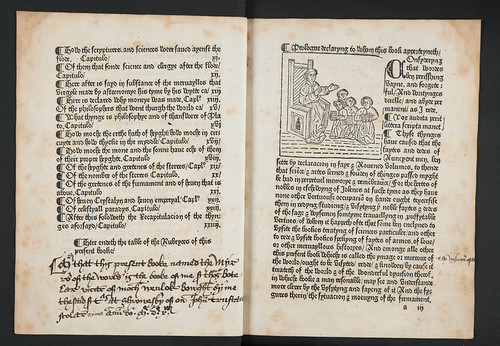Gossuin de Metz: Myrrour of the worlde.
Translated from the French, L’image du monde, by William Caxton.
[Westminster]: William Caxton, [ca. 1489-90]
Fol. a-k8 (± k2.7) l8. [88] leaves.
Woodcuts, woodcut initials, woodcut device. In most copies sheet k2.7 is a cancellans (see BMC).
ISTC im00884000; GW 10967; Goff M884; BMC XI 170 (IB. 55142); DeR(C) 95.10.
Gossuin or Gautier de Metz was named as author in some of the manuscript sources. The attribution to Vincent de Beauvais (e.g. by De Ricci and STC) is erroneous.
| GIP number: | G41 |
| Shelf-mark: | Sp Coll Hunterian Bv.2.30 (see main library entry for this item) |
| Provenance: | Sir Thomas Botelar/Boteler/Butler (1487(?)-1571), Vicar of Holy Trinity, Much Wenlock, Shropshire, parish church of the Priory of S. Milburga: inscription on a2v “... this present Booke named the Myrro[ur] of the World is the booke of me s[ir] tho[ma]s Botelar vicar of moch wenlok Bowght by me the said s[ir] t[hom]as at Shrowesb[ur]y of on[e] John trustanes scolar circa an[n]u[m] do[mini] m.d.x.”. John Trustanes (fl.1510): see above Anne Greasbrooke (17th century): name “Anne Greasbrooke” on a1r. William Barnesley (17th century): name “William Barnesley” on a1r. John Ratcliffe (1707-1776), book collector: lot 1017 in Bibliotheca Ratcliffiana (1776). William Hunter (1718-1783), physician and anatomist: purchased by Hunter for £4.17.0 at the Ratcliffe sale according to the annotated British Library copy of the Ratcliffe sale catalogue (shelfmark 822.d.6). University of Glasgow: Hunterian bequest 1807; Hunterian Museum bookplate on front pastedown, with former shelfmark “K.6.13”. |
| Binding: | England, mid 18th-century gold-tooled red goatskin; covers have a dentelle border formed by an outer saw-tooth roll and repeated impressions of an arched tool incorporating an insect (bee or wasp?) with a backward-looking bird perched on top of each arch; the same border appears on the covers of three other English incunables previously owned by Ratcliffe and now in the Hunterian Library: (1) John Lydgate, The Life of Our Lady. [Westminster]: William Caxton, [1483] (shelfmark Bv.2.20, GIP number L42); (2) Ranulphus Higden, Polycronicon. [Westminster]: William Caxton, [between 2 July and 8 Oct. 1482] (shelfmark Bv.2.9, GIP number H28); (3) Geoffrey Chaucer, Canterbury Tales. [London]: Richard Pynson, [between June 1491 and 13 Nov. 1492] (shelfmark Bv.2.12, GIP number C33/2); gold-tooled spine; dark blue endpapers; gilt-edged leaves. See also Christie’s Wentworth sale (8 July, 1998), lot 5 (Le doctrinal de sapience, Westminster: Caxton, [after 7 May 1489]), for a binding with identically tooled covers. Size: 237 x 181 mm. |
| Leaf size: | 232 x 175 mm. |
| Annotations: | Occasional marginal annotations in English in various 16th-century hands (mainly cropped); very occasional underlining and nota marks; names of three continents “Asia”, “Europa”, “Africa” and of the four cardinal points have been added to one of two woodcut diagrams of the earth on d7v. |
| Decoration: | None. |
| Imperfections: | Wanting l8 containing Caxton’s device (according to BMC, De Ricci 95.10 was wrong in supposing that the missing leaf I8 from the Hunterian copy was removed by Andrew Gifford to perfect his own copy, which was then bequeathed to the Baptist College Library, Bristol, in 1784, and later purchased, in 1960, by the British Library). |








